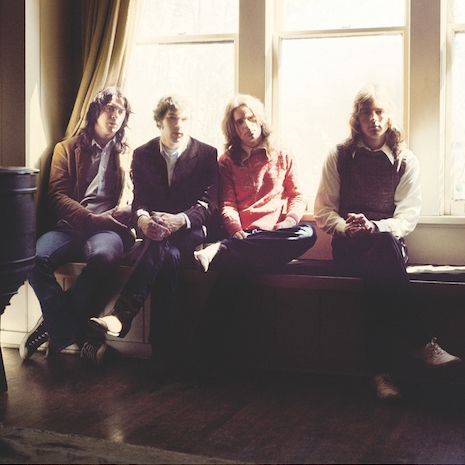
Big Star’s original lineup. L-R: Andy Hummel, Chris Bell, Alex Chilton, and Jody Stephens.
Being a big fan of Big Star, I was excited to receive an advance copy of the oral history book, There Was a Light: The Cosmic History of Chris Bell and the Rise of Big Star. I started flipping through it and was immediately drawn to the story of the Baker Street Regulars. The band existed for a brief period in 1976, and featured two former members of Big Star, Chris Bell and Jody Stephens. Considering this was a seldom discussed part of the Big Star story, I asked HoZac Books if we could run the Baker Street Regulars passages in the book. They not only said “Yes,” but provided us with the majority of the images here—many of which have rarely been seen before. There Was a Light author, Rich Tupica, has even written an introduction just for us.

Chris Bell in Ardent Studios, pre-Big Star.
Often overshadowed by his iconic Big Star bandmate Alex Chilton, the genius of the late Chris Bell wasn’t truly uncovered until years after he was tragically killed in a car wreck in December 1978. The 27-year old remained in obscurity until 1992, when I Am the Cosmos, his posthumously released solo album was finally released to much praise.
Today, Beck and Wilco cover the enigmatic songwriter’s works, while members of R.E.M. still praise his work when asked about their favorite bands—yet at the time of his death, Bell was anything but a rock ’n roll legend. After the release of 1972’s #1 Record, Big Star’s debut LP on Ardent/Stax Records, Chris suffered a bout a clinical depression and heatedly exited the Memphis-based group—the band he masterminded from the ground up. He also had a falling out with Ardent Studios owner and Big Star producer John Fry. His life was in shambles and he realized his dream of breaking Big Star into the mainstream wasn’t going to happen.
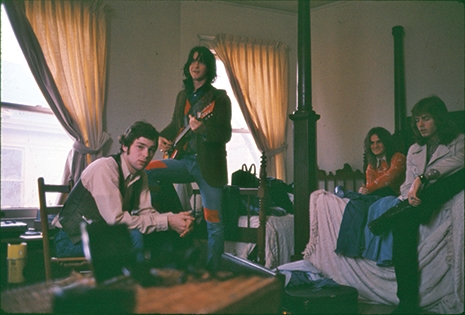
Big Star in Alex Chilton’s bedroom, posing for a ‘#1 Record’ promo photo. (Courtesy of Carole Manning)
With Bell out of the picture, Alex Chilton and John Fry took the reins and kept Big Star going for two more equally acclaimed albums, Radio City and Third/Sister Lovers—but with little financial successes, the band fully dissolved.
Meanwhile, Bell not only became a devout born again Christian, he also attempted to launch a solo career. He even moved to London with his older brother David Bell for much of 1975 and pitched his reels of solo material to any A&R rep who’d meet with them. They were ultimately turned down by every label. By 1976, America’s Bicentennial, Chris was back in Memphis living at his parent’s upper-class estate in Germantown.
For money, Bell flipped burgers at his successful father’s fast food chain, while in the evenings he played as a sideman guitar slinger alongside fellow Memphians Van Duren in a short-lived band called the Baker Street Regulars. The band would never record a single track, but its short list of dates at low key Memphis bars would be the only time a full band would ever play Chris Bell’s solo material in front of an audience.
The following excerpt is a portion of Chapter 20 from the new oral history book, There Was a Light: The Cosmic History of Chris Bell and the Rise of Big Star (HoZac Books), details this transitional period of Bell’s life.
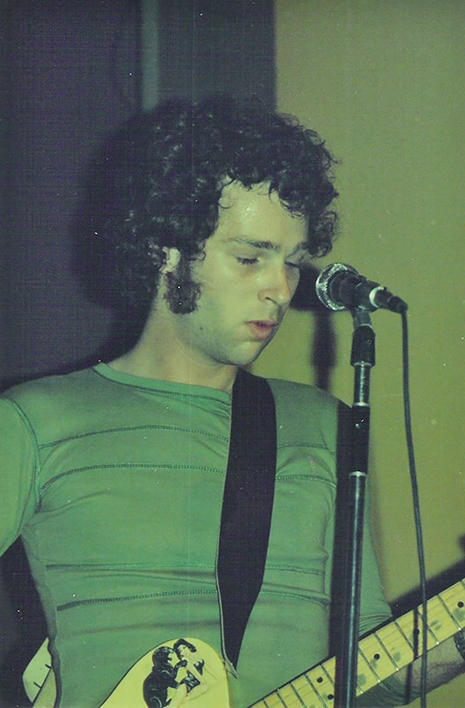
Chris Bell on stage during a Baker Street Regulars gig. (Courtesy of Van Duren)
Chapter 20: Baker Street Regulars: 1976
Within weeks of his return from England, Chris connected with Van Duren and promptly formed the Baker Street Regulars—a Memphis-based bar band named after the Sherlock Holmes characters. The group—which also comprised former Big Star drummer Jody Stephens and guitarist Mike Brignardello—played Van’s and Chris’s original tunes along with some semi-obscure covers. For the first time since his pre-Big Star days, Chris played music just for fun.Mike Brignardello — Bassist, Baker Street Regulars, Nashville session player: I grew up in Memphis, then hit the road immediately after high school in the early ’70s. I was in a little club band and learning about being a musician, then I came back in the mid-’70s. Big Star had come and gone in my absence, but I heard about them when I got back. They were local heroes, already a semi-cult band. One of the first guys I met when I came back to Memphis was Van Duren. We hit it off and started playing together. He was the guy who hooked us up with Chris and Jody.
Van Duren — Musician, songwriter, solo, Baker Street Regulars: The Baker Street Regulars was the name when the band first started—Chris thought of it. In December of ’75, we started to get together and rehearse, but we had been kicking around the idea of forming a band for months before that. The first time I went out to the Bells’ house, Jody took me over there for our first rehearsal. We turn off down this street and it turned into this winding driveway. You couldn’t even see the house from the street, the property was so huge.

Chris Bell poses in front of his parents’ home, Christmas 1977. (Courtesy of Bell Family Archive)
Mike Brignardello: Chris lived in, to my eyes—at least back in the day—a full-blown mansion. I remember turning down the driveway and driving, and driving, and driving and thinking, “You’ve got to be kidding me! He lives on this estate?” I had grown up as a poor kid in Memphis. He had us set up and play in the living room because his parents were overseas for like a month. I was like, “Who goes overseas for a month?”
Van Duren: Chris was different, obviously upper crust. I come from a blue-collar background, so that was a new world for me. He was from privilege and he acted that way sometimes, but he could also be quite humble. He always had a twinkle in his eye, much like Alex in a way. Sometimes you couldn’t tell if he was putting you on or being serious.
Mike Brignardello: We practiced in a corrugated-metal storage room—it wasn’t insulated or anything like that. We’d just roll the door up on hot, humid Memphis days and rehearse. My girlfriend got that photo of us in there. I thought it perfectly summed up where we were at. We were hungry to play. We sweat through those rehearsals.
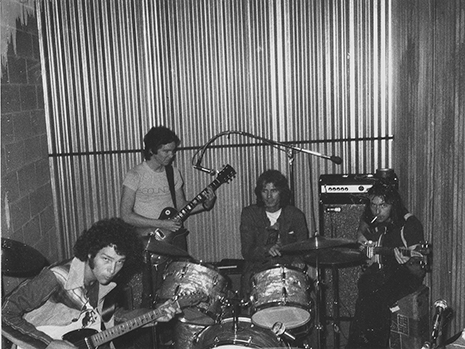
The Baker Street Regulars in the metal storage unit. L-R: Chris Bell, Mike Brignardello, Jody Stephens, and Van Duren. (Courtesy of Beverly Baxter Ross)
Van Duren: It was pretty miserable in that twenty-foot-by-ten-foot mini storage—those things were brand-new in 1976. It was on Lamar Avenue and was the first of its kind in Memphis. One day, Chris showed up two hours late for rehearsal out there. He walks in wearing these tennis togs with the sweater wrapped around his neck and says, “Sorry I’m late, Tommy Hoehn and I had a vision on the tennis courts.” I didn’t know if it had to do with his religious beliefs, or if I was supposed to take him seriously or not. I was a little bent out of shape, but I just laughed when he said that. It wasn’t the first or the last time he was late. He operated on Chris time. Even so, by January of ’76, we were out playing.
The Baker Street Regulars landed shows at now-defunct venues, like Aligahpo’s on Highland Street by the University of Memphis, Procapé Gardens in Midtown on Madison, and the High Cotton Club, just south of Overton Square.
Van Duren: We played those three clubs about three times each, but the first gig was in the springtime in Oxford, Mississippi at Ole Miss at a fraternity party. We did originals and some cover material—but the covers were Beatles, Bee Gees and a lot of fairly obscure things at the time, like Todd Rundgren. We played things nobody had picked up on yet, especially in Mississippi. We threw in my songs, some Big Star songs and a few of Chris’s songs. We’d do “I Am the Cosmos,” “Make a Scene” and “Fight at the Table.” We learned Chris’s songs by listening to what he was calling demos—what later emerged as his solo album. It was a wonderful experience, even though when we played gigs we were pretty much ignored. That’s probably why we didn’t play much in the six months we were together.
Jody Stephens — Producer, drummer, Baker Street Regulars: There just wasn’t much of an opportunity for the Baker Street Regulars to play. Not even Big Star could find a proper booking agent, or a proper manager. That’s why we didn’t play too often—there just wasn’t a demand for it.
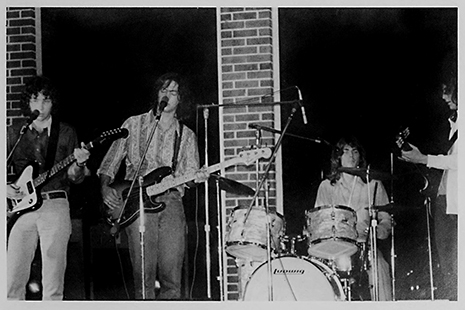
The original lineup of Big Star performing at Athens State College, now Athens State University. (Courtesy of Athens State University Archive)
Van Duren: Big Star was still unknown in Memphis. I just loved #1 Record. I thought it was phenomenal beyond words, but we didn’t have people showing up to our Baker Street Regulars gigs and saying to Chris, “Wow, you were on #1 Record! Can I have your autograph?” But we did land some shows. There was a spot out in southeast Memphis called The Underground. It was built into a hill so one side of it was underground. Chris showed up late to that show. We were supposed to start playing at about 9:30 p.m. and go until 1:30 a.m. This was an April or May gig, Richard Rosebrough was filling in on drums. I’m not going to say the place was packed, but there were forty or fifty people in the room. It’s like 9:25 p.m. and Chris isn’t there yet. The rest of us are all set up and sound checked for about an hour.
Finally, he walks in. He’s got his Gibson 330 in one hand—no case, just his guitar. In his other hand is a Fender amplifier he’s borrowed from somebody. He sets the amp up and then sits down on the edge of the stage and starts changing his strings. I was not happy. I’ve always been one of those people who wants to keep working. He had his own world. Let’s face it: He’s a rich kid.
Even in its lifespan of just a few months, the Baker Street Regulars went through some fluctuations. In April 1976, the band’s name changed to Walk ‘n’ Wall and soon after Jody stepped down as drummer. From there, future Ardent Studios engineer John Hampton stepped in behind the kit. His brother, guitarist Randy Hampton, also briefly performed with the fluid lineup. Richard Rosebrough filled in on drums for most out-of-town gigs.
John Hampton — Producer, drummer, Baker Street Regulars: Jody quit the band and then I started playing drums. That was my official getting-to-know Chris. We rehearsed quite a bit together as a band and played a couple shows…This was a great rock band. It was part Big Star, blended with the best Brit-pop covers around and Van’s Paul McCartney-meets-Paul Carrack lead vocals.
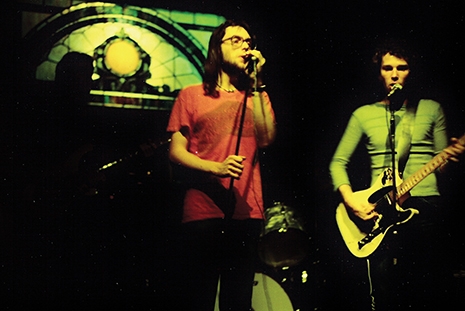
The Baker Street Regulars performing at Procapé Gardens in Memphis. (Courtesy of Van Duren)
Van Duren: We played at least one private event, one of them was Chris’s sister’s wedding reception. That was the first week in June 1976.
John Hampton: One of Chris’s million sisters were getting married and we were going to be the music at the reception. Having met some of his sisters, this felt more like someone was doing Chris a favor, as his whole family seemed to be a bit too conservative to want us. Then again, if we kept to Beatles covers, obscure Rundgren and Badfinger, and threw in Chris’s and Van’s originals, we might just pull it off. The gig was Saturday night at 8 p.m. Randy, Van and I were there an hour early, our usual thing—but no Chris.
Van Duren: Of course, Chris shows up late. In hindsight, Chris was hilarious. Hampton was on drums that night. It was a nice country club setting and we’re all set up.
John Hampton: Chris was late as crap, but eventually he comes walking in wearing a white shirt and white tennis shorts with a sweater tied around his waist. He also had a Telecaster over his shoulder and was holding a Fender Concert amp. As Van approached Chris, I’m sure to bitch about his timing, Chris had already plugged in the amp and the guitar into it. “Oh, hell—he just maxed out the knobs.” In slow motion, as Van’s mouth opened to speak, a sound straight out of hell came out of the amp. It was the first lick of Zeppelin’s “Heartbreaker” solo. Van kept talking as Chris’s eyes combed the room, surely to see how many girls were covering their ears. About sixty percent. Good work, Chris.
With Van now talking at him, Chris decided there was too much top end, lowered the treble on the amp and played the lick again, this time with a little more conviction. Which is exactly how Jimmy Page starts the solo on “Heartbreaker.” Chris blazed through the rest of the solo, note for note, but he added good where Page went bad. Van gave up, and as the end of the solo got near, Chris once again peruses the room, which by now had all but cleared out, pushed out by the sheer volume. Finally, when he saw my approving smile, he smiled back. I guess we both had a little anarchist in us.
The gig went from there without a hitch, but that solo was forever burned into my synapses. It was as if he was showing everyone how good he could be if he chose to be, so back off. Quite the statement.
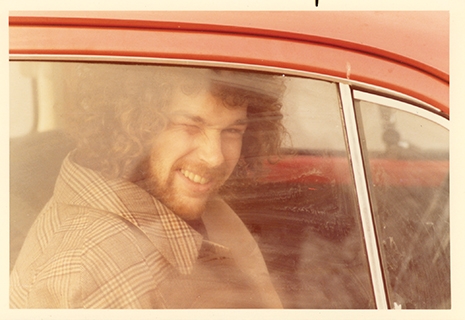
Chris Bell in England, 1975. (Courtesy of David Bell)
Richard Rosebrough: There was another gig in northern Mississippi. John Hampton was the regular drummer but this night I subbed. It was at a Holiday Inn, Howard Johnson’s or something. My bass drumhead, the back head, broke. It started splitting as soon as we started playing. It was breaking quickly, and I didn’t have a replacement for it. I still had two more hours I was supposed to play on that drum loudly. We taped it up with all this gray roadie tape. I was just freaking out. We took a break and I told Chris, “Man, my bass drum is broken. I just don’t know what to do!” He said, “Have you tried praying?” I said, “No! But it’s about to break.” He said, “Well, let’s pray.” We got down on the floor, behind the bass drum, and we had a little prayer session.
Van Duren: That was the last gig we did with Chris and Richard. By then, Chris had already started playing lead guitar with Keith Sykes because our gigs were sparse. Our band was not getting anywhere, and we were all chomping at the bit to do something else. By June 1, Chris left to concentrate on his new job at Danver’s, his dad’s restaurant, but he kept playing with Keith because those were better-paying gigs. After he left, Mike, John and I continued Walk ’n’ Wall as a trio through the summer.
Unfortunately, we never recorded anything with Chris when he was in the band, didn’t even record a live show. The only recording session I ever did with Chris was the first version of my song “New Year’s Eve.” Jody and I brought in Chris to play electric guitar. Some of it was re-cut and ended up on my first album.
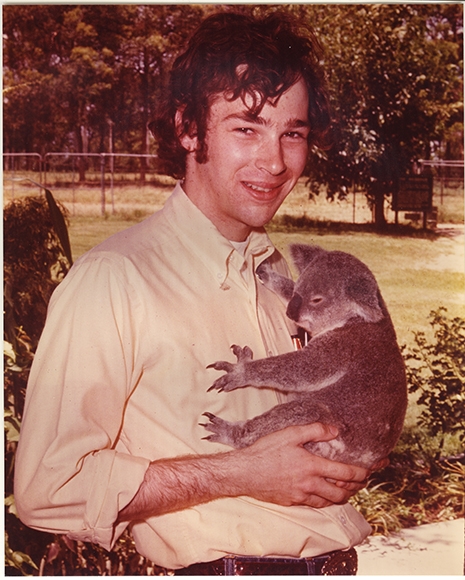
Chris Bell poses with a koala during a 1972 trip to Australia. (Courtesy of Ardent Studios Archive)
Excerpted from There Was a Light: The Cosmic History of Chris Bell and the Rise of Big Star by Rich Tupica (HoZac Books).

The tale of the Baker Street Regulars is just one of many great stories in There Was a Light. Through new and archival interviews, author Rich Tupica lays out the fascinating histories of Chris Bell and Big Star. The book, which is packed with amazing photos, will be released on September 21. Pre-order your copy through HoZac’s website, or get it via Amazon.
Previously on Dangerous Minds:
Meet the enigmatic Gimmer Nicholson, whose ill-fated 1968 album influenced Alex Chilton & Big Star